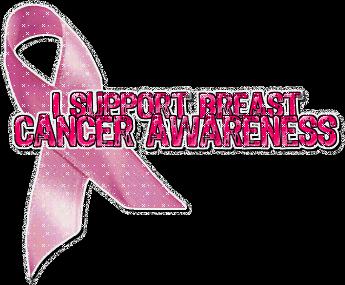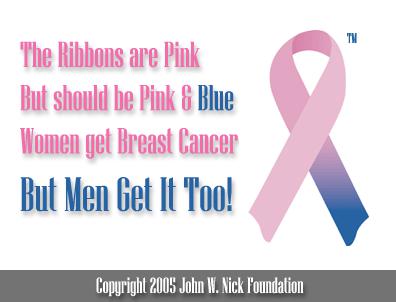 As I was searching for ways for my husband and son to support Breast Cancer Awareness, I became annoyed.
As I was searching for ways for my husband and son to support Breast Cancer Awareness, I became annoyed.
I don’t mind that everything Breast Cancer related, is pink. I know that my son and husband don’t mind it either, as I am sure many men don’t. After all, it’s not about the color it’s about the cause! But, what bothered me is how everything is aimed towards women…delicate jewelry, frilly, girly items, and “Fight like a girl” slogans. Where are the “I FIGHT FOR my girl” or “I FIGHT WITH THE GIRLS” slogans?
Yes, it is true, that more women are diagnosed with Breast cancer than men but, tell me why there aren’t any clothing, jewelry, gift baskets, etc… for men? Even if you ignore the fact that men also get Breast Cancer, why are men excluded from supporting their mother’s, sister’s, aunt’s, grandmother’s, or wife’s…in a more manly fashion? There should be more items available to boys and men to not only support the females in their life who are afflicted but, to also support the men who are afflicted every year. A little pink never hurt anyone, but how about some man-sized shirts, necklaces, bracelets…something that says, I wear pink because I love and support this person who is battling this horrendous disease and I don’t have to look like a cross-dresser to do it.

Cafepress
Now as you may have gathered, For Jens Sake is participating in a month-long Breast Cancer Awareness drive. It is the goal of myself and many other bloggers to not only raise awareness about this disease but, to educate as well.

The biggest misconception is that Breast Cancer is solely a woman’s disease. It is not! Men are not immune. Any person who has studied Biology in school or has had a sexual education class should already know that, both boys and girls have breast tissue.
Where breast cancer begins in men:
Everyone is born with a small amount of breast tissue. Breast tissue is made up of milk-producing glands called lobules, ducts that carry milk to the nipples and fat. Women begin developing more breast tissue during puberty and men do not. Because they are born with a small amount of breast tissue, men can develop breast cancer.
Another reason that Breast Cancer is considered as solely a woman’s disease has to do with statistics. There just aren’t as many male cases as there are female cases. But, that doesn’t mean men can’t get Breast Cancer.
What are the key statistics about breast cancer in men?
The most recent American Cancer Society estimates for male breast cancer in the United States are for 2011:About 2,140 new cases of invasive breast cancer will be diagnosed among men.
About 450 men will die from breast cancer.
Breast cancer is about 100 times less common among men than among women. For men, the lifetime risk of getting breast cancer is about 1 in 1,000. The number of breast cancer cases in men relative to the population has been fairly stable over the last 30 years.The prognosis (outlook) for men with breast cancer was once thought to be worse than that for women, but recent studies have not found this to be true. In fact, men and women with the same stage of breast cancer have a fairly similar outlook for survival.
The signs and symptoms of Breast Cancer are the same in men and women. This is why it is extremely important to do a monthly self exam on yourself and know your body.
Signs and symptoms of male breast cancer can include:
-A painless lump or thickening in the breast tissue
-Changes to the skin covering your breast, such as dimpling, puckering, redness or scaling
-Changes to your nipple, such as redness, scaling or a nipple that turns inward
-Discharge from your nipple
If you suspect that something is out of the ordinary; schedule an appointment and have a doctor examine you. Both men and women are examined in the same fashion, to rule out or diagnose Breast Cancer.
Diagnosing male breast cancer:
If breast cancer is suspected, your doctor may conduct a number of diagnostic tests and procedures such as:
Clinical breast exam. During this exam, your doctor uses his or her fingertips to examine your breasts for lumps or other changes. Your doctor assesses how large the lumps are, how they feel, and how close they are to your skin and muscles. Your doctor will also examine the rest of your body for signs that the cancer has spread, such as feeling for an enlarged liver or enlarged lymph nodes.
Mammogram. A mammogram is an X-ray of your breast tissue. To assess your breast tissue, your breast will be pressed flat as much as possible. During a mammogram, you stand in front of a machine with your shirt off. Two flat plastic plates come together to compress your breast tissue. A radiology technician takes the X-rays. The compression of the mammogram can be uncomfortable. Ask the technician what to expect and speak up if you’re feeling pain.
Breast ultrasound. Your doctor may recommend an ultrasound of your breast to evaluate an abnormality seen on a mammogram or found during a clinical exam. Ultrasound uses sound waves to form images of structures within the body.
Testing nipple discharge for cancer cells. Your doctor may collect nipple discharge if you’re experiencing it. The discharge is then examined using a microscope to look for cancerous cells.
Using a needle to remove cells for testing. A biopsy procedure involves removing a sample of suspicious tissue for laboratory testing. A breast biopsy is commonly done by inserting a needle into the breast lump and drawing cells or tissue from the area. When analyzed in a laboratory, your tissue sample reveals whether you have breast cancer and, if so, what type of breast cancer you have.
If it is determined that you have Breast Cancer the doctor will be able to tell you in what stage your cancer is in and what type of Breast Cancer you have.
Determining the extent of the cancer:
If you’ve been diagnosed with breast cancer, your doctor will work to determine the extent (stage) of your cancer. Your cancer’s stage helps your doctor determine treatment options. Staging tests include blood tests and imaging tests, such as X-rays, computerized tomography (CT) and magnetic resonance imaging (MRI).The stages of male breast cancer are:
Stage I. The tumor is no more than 2 centimeters (cm) in diameter (3/4 inch) and hasn’t spread to the lymph nodes.
Stage II. The tumor may be up to 5 cm (2 inches) in diameter and may have spread to nearby lymph nodes. Or the tumor may be larger than 5 cm and no cancer cells are found in the lymph nodes.
Stage III. The tumor may be larger than 5 cm (2 inches) in diameter and may involve several nearby lymph nodes. Lymph nodes above the collarbone may also contain cancer cells.
Stage IV. Cancer at this stage has spread beyond the breast to distant areas, such as the bone, brain, liver or lungs.
Types of breast cancer diagnosed in men include:Cancer that begins in the milk ducts. Ductal carcinoma is the most common type of male breast cancer. Nearly all male breast cancers begin in the breast ducts.
Cancer that begins in the milk-producing glands. Lobular carcinoma is rare in men because men have few lobules in their breast tissue.
Cancer that spreads to the nipple. In some cases, breast cancer can form in the breast ducts and spread to the nipple, causing crusty, scaly skin around the nipple. This is called Paget’s disease of the nipple.
Inherited genes that increase breast cancer risk.
Some men inherit mutated genes from their parents that increase the risk of breast cancer. Mutations in one of several genes, especially a gene called BRCA2, put you at greater risk of developing breast and prostate cancers. Usually these genes help prevent cancer by making proteins that keep cells from growing abnormally. But if they have a mutation, the genes aren’t as effective at protecting you from cancer.Meeting with a genetic counselor and undergoing genetic testing can determine whether you carry gene mutations that increase your risk of breast cancer. Discuss the benefits and risks of genetic testing with your doctor.
Everyone will tell you how important it is to catch cancer early. It is very, very important to catch it early. Therefore you need to self-exam and get regular checkup’s by a medical practitioner.
Let’s end the stereotype that Breast Cancer is a woman’s disease. Breast Cancer is clearly less common in men than in women but, it doesn’t care which sex you are. Men are not immune so please don’t be bashful, get yourself checked and don’t become a victim to Breast Cancer.
Don’t forget to get involved, support Breast Cancer Awareness and education. Because cancer doesn’t affect one it affects all!
For Jens Sake and Blognostics Joining Forces For Pinktober
Breast Cancer Awareness Month: Anger
Faith, Hope, Love, and Awareness
What Breast Cancer Awareness Means to Me
The Pink Ribbon Challenge
Breast Cancer Awareness Pinktober
Pinktober Is Amongst Us

